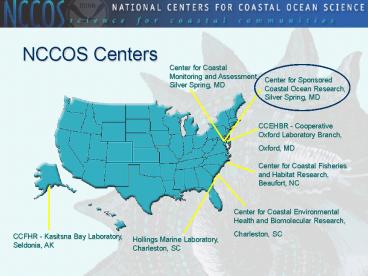NCCOS Centers - PowerPoint PPT Presentation
1 / 12
Title:
NCCOS Centers
Description:
... degradation to fishery outcomes: a bioeconomic approach based on brown shrimp ... impact of hypoxia-induced changes in shrimp ecology on fishing behavior, and its ... – PowerPoint PPT presentation
Number of Views:48
Avg rating:3.0/5.0
Title: NCCOS Centers
1
NCCOS Centers
Center for Coastal Monitoring and Assessment,
Silver Spring, MD
Center for Sponsored Coastal Ocean Research,
Silver Spring, MD
CCEHBR - Cooperative Oxford Laboratory Branch,
Oxford, MD
Center for Coastal Fisheries and Habitat
Research, Beaufort, NC
Center for Coastal Environmental Health and
Biomolecular Research, Charleston, SC
CCFHR - Kasitsna Bay Laboratory, Seldonia, AK
Hollings Marine Laboratory, Charleston, SC
2
Hypoxia research drivers
- Harmful Algal Bloom and Hypoxia Research and
Control Act (HABHRCA) - In reauthorization right NOW
- Assessment of Hypoxia Report due 2008
- NOAA Eutrophication Assessment UPDATE 2007
- http//ccma.nos.noaa.gov/publications/eutroupdate/
- Priority Topics for Nutrient Pollution in Coastal
Waters An Integrated National Research Program
for the United States (2003) - US Commission on Ocean Policy 2001
3
The Dead Zone has more than doubled in size since
the 1980s due to increased nutrient loading from
the Mississippi River watershed.
In summer 2007, the Dead Zone was 7,900 square
miles, the 3rd largest on record, and close to
the size of New Jersey.
4
Updated Action Plan
- reduce the 5-year running average of the hypoxic
zone to less than 5,000 km2 by the year 2015 - Reduce Nitrogen by 45
- Reduce Phosphorous by 40
- Rough draft due to the Task Force in 2 weeks!
5
- Coastal Hypoxia Research Program (CHRP)
- An outgrowth of the long-term Gulf of Mexico
hypoxia program - Support research on hypoxia in other regions
- Objectives
- Develop a fundamental understanding of the causes
of hypoxia, including the role of anthropogenic
vs. natural influences - Develop the capability to predict the occurrence
of hypoxia in response to varying levels of
anthropogenic stress, and to evaluate the
subsequent ecological, economic, and social
impacts
6
CHRP Goal To provide research results and
modeling tools which will be used by coastal
resource managers to assess alternative
management strategies for preventing or
mitigating the impacts of hypoxia on coastal
ecosystems.
7
CHRP Portfolio
- 34 scientists at 18 institutions are
investigating hypoxia in a range of systems - Narragansett Bay
- Albemarle Estuary
- Puget Sound
- Delaware Coastal Bays
- Atlantic and Gulf Coast Estuaries
- Chesapeake Bay and Delaware Inland Bays
8
Modeling Hypoxia and Ecological Responses to
Climate and Nutrients
- WM Kemp (Horn Point), W. Boynton (CBL), D. DiToro
(UDel), K. Fennel (Dalhousie), M. Li (Horn Pt),
E. North (Horn Pt), D. Secor (CBL) - Region Chesapeake Bay and Delaware Inland Bays
- produce models that will predict the extent of
seasonal and shorter term episodic hypoxia and
other ecological responses (e.g. water quality
and fishery production) to interactive effects of
nutrient loading and climatic factors including
wind, tides and temperature. - ROMS (physical circulation) and RCA-Aesop
(biogeochemistry)
9
- Linking hypoxia-induced habitat degradation to
fishery outcomes a bioeconomic approach based on
brown shrimp - Kevin Craig, Larry Crowder, Martin Smith (Duke
University) - Region Albemarle-Pamlico estuarine system
- Develop a individual-based population model to
assess consequences of hypoxia severity on shrimp
production - Develop a bioeconomic model that incorporates
the impact of hypoxia-induced changes in shrimp
ecology on fishing behavior, and its economic
consequences
10
Watershed-Estuary-Species Nutrient Susceptibility
- D. Scavia G. Helford (U Mich), R. Howarth
(Cornell), R. Alexander (USGS), D. Breitburg
(SERC) - Regions Atlantic and Gulf Coast Estuaries
- Integrate existing data and models to allow flow
of information, forecasts, and scenarios from
watershed and climate change, through
hydrologically-modulated estuarine susceptibility
to potential impacts on upper trophic levels.
11
- Historical trends of hypoxia in three basins of
Puget Sound - Eric Crecelius, Jill Brandenberger (Battelle
Memorial Institute), Sherri Cooper (Bryn Athyn
College), Estella Leopold (U. Washington),
Patrick Louchouarn (Columbia U.), Kristin
McDougall (USGS) - Region Puget Sound
- Provide resource managers with tools
(biomarkers) to indicate a basins status with
respect to the stage of hypoxia progression, and
to enhance predictive capabilities to evaluate
alternative management strategies on hypoxia
development
12
- Linking water quality models with
individual-based models to investigate impacts of
diel-cycling hypoxia on nursery habitat quality
for estuarine dependent fishes - Timothy Targett, Dominic Di Toro (University of
Delaware), Robert Diaz (VIMS) - Region Delaware Coastal Bays
- Integrate water quality and individual-based
models to assess the impact of hypoxia and other
outcomes of eutrophication on fish production and
health.

